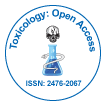开放获取期刊获得更多读者和引用
700 种期刊 和 15,000,000 名读者 每份期刊 获得 25,000 多名读者
索引于
- 谷歌学术
- 参考搜索
- 哈姆达大学
- 亚利桑那州EBSCO
- 日内瓦医学教育与研究基金会
- 欧洲酒吧
- ICMJE
有用的链接
开放获取期刊
分享此页面
抽象的
When Present in Caenorhabditis Elegans at Quantities Comparable to Those in Contaminated Areas, Perfluorooctanoic Acid (PFOA) Causes Toxicological Effects on Behaviour, Reproduction, and Development
Mendeley James, Robert Friday
The persistent organic pollutant (POP) perfluorooctanoic acid (PFOA) is widely distributed in the environment. Globally, there is growing concern over the possible hazardous effects of PFOA on both human and ecological health. In this work, we examined the acute toxicity of PFOA on Caenorhabditis elegans (C. elegans), a species of free-living, ecologically significant animal model. We looked at growth, mortality, lifespan, neurobehavior, fertility, and livelihood. 4.42 M (1.83 mg/L) was discovered to be the acute toxicity (LC50) of PFOA. The locomotor behaviour of C. elegans was altered by PFOA exposure. Additionally, after being exposed to 0.1 M (41.4 g/L) PFOA, C. elegans' ability to reproduce was diminished. Likewise, the modification in chemotaxis plasticity and lifespan reduction above 1 M (414 g/L) PFOA were both evidence of developmental toxicity

 English
English  Spanish
Spanish  Russian
Russian  German
German  French
French  Japanese
Japanese  Portuguese
Portuguese  Hindi
Hindi